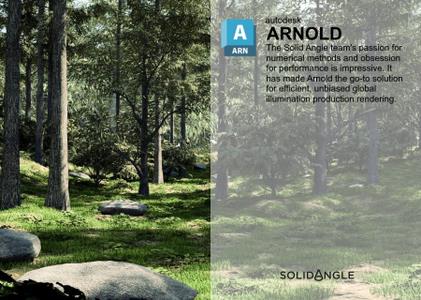
Solid Angle Cinema 4D to Arnold 4.3.0 | 5.6 Gb
Product:Solid Angle Cinema4D to Arnold
Version:4.3.0
Supported Architectures:x64
Website Home Page :www.arnoldrenderer.com
Languages Supported:english
System Requirements:Windows / macOs / Linux *
Size:5.6 Gb
The software developer Solid Angle announced the launch of Arnold (C4DtoA) 4.3.0 for Cinema4D. This update uses Arnold 7.1.3.0 and is a major feature release bringing several improvements to volume shading, improvements to imagers in the IPR window, faster procedurals in the viewport and a new C++ API for third-party developers.
4.3.0 - Date: 03.08.2022
-New C++ API:The C++ API has been completely rewritten. Third-party developers must update their C4DtoA extensions to the new API. Examples can be found in the $C4DTOA_INSTALL/api/examples folder. (C4DTOA-2677)
-Imager IPR window toolbar button:A new button is added to the IPR window toolbar to enable/disable imagers in the scene and interact with imagers via its context menu. (C4DTOA-2744)
-Rename imagers from the IPR window:Imagers can now be renamed from the Post panel of the IPR window by double click on the name. (C4DTOA-2772)
-Improved procedural viewport performance:Displaying shapes of an Arnold Procedural in the viewport is now much faster. (C4DTOA-2113)
-Displacement height default value:Displacement Height default value in the Arnold tag has been changed from 100 cm to 10 cm. (C4DTOA-2763)
-Status info:Long running tasks during rendering (e.g. compiling shaders on GPU, etc.) are now displayed in the IPR window and Picture Viewer status bar. (C4DTOA-2043)
-Dual-lobe phase function for standard_volume:A new phase function model has been implemented for the standard_volume shader, which is a mixture of two lobes rather than a single lobe as before. This provides a more realistic approximation to the physical phase function of scattering media such as clouds. The new model adds two new parameters, scatter_secondary_anisotropy (in [-1,1]) and scatter_secondary_anisotropy_mix (in [0,1]). (ARNOLD-9335).
The cloud on the left (below), using the default anisotropy (0) settings, does not show much forward scattering. The center image (anisotropy 1: 0.7, anisotropy 2: 0.7) shows a strong "silver lining" at the rim of strongly forward scattered light from the sun behind. The cloud on the right (anisotropy 1: -0.4, anisotropy 2: 0.7) adds a secondary phase function lobe which fills in the bulk of the cloud with back-scattered light while maintaining the silver lining.

The image below shows the full parameter space of the new dual-phase function model (each cell shows the phase function shape for a given combination of lobe anisotropies, which varies as the lobe mix weight is animated). The blue curves correspond to the old single lobe model.
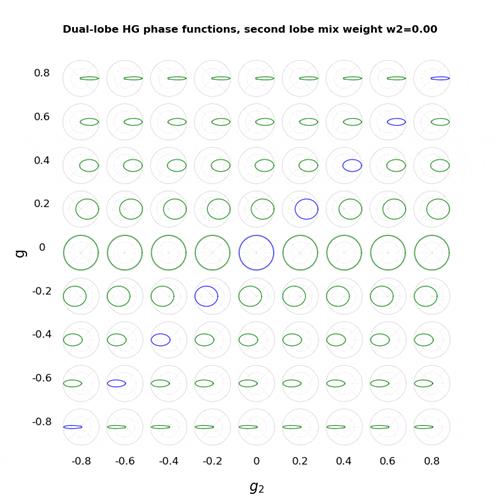
-Physically correct volume emission scaling:The standard_volume shader has been improved to support scaling of volumetric emission in a more physically correct manner (via the emission_scaling option). The "opacity" emission scaling mode is based on density and transparency and scaled appropriately to the opacity of the resulting volume. This is physically accurate for blackbody if the scattering color is black. The "thermodynamic" emission scaling mode is the most physically correct as it also takes into account scattering color, since according to thermodynamics volumes with higher scattering albedo emit less blackbody radiation. For example, burning hydrogen produces steam but barely emits blackbody radiation while sooty smoke readily does. This mode is most useful when mixing different types of volumes with varying scattering properties. (ARNOLD-11701).
The images below show the effect of the scaling mode on blackbody emission. The difference between opacity and thermodynamic modes here is that in thermodynamic mode the white, highly scattering smoke does not emit, while the black smoke does (which is a slightly subtle effect but more physically correct).
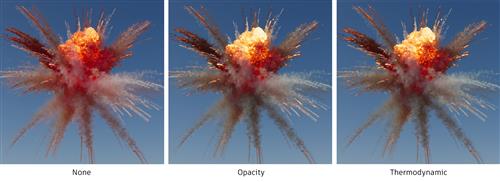
-Other volume emission improvements:The blackbody_intensity control can now be dialed above 1 for convenience. A blackbody_contrast parameter has also been added to (non-physically) reduce the brightness difference between parts of the volume at different temperatures, which can be useful for artistic purposes. (ARNOLD-11701). The images below show the effect of altering the new blackbody_contrast parameter. This reduces the disparity in brightness between parts of the volume at different temperatures, which tends to bring out the blackbody colors more vividly (though note that only value 1 is physically correct).
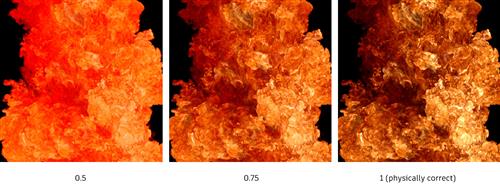
-Pinned curves:A new wrap_mode parameter on curves can enable curve pinning. Pinned non-periodic curves go through the first and last point without having to introduce phantom points, thus reducing the amount of data stored on disk. (ARNOLD-12209)
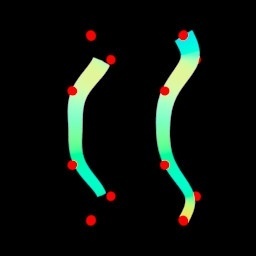
-Nested instancers:Nested instancers (instancer that contains instances of instancers) now properly perform instancing, fixing a severe overhead in node init/update time that made heavy use of nested instancers intractable. (ARNOLD-12410)
-Cameras in ASS procedurals:Cameras stored in .ass file procedurals can now be used for rendering. (ARNOLD-12333)
-Reduced missing texture overhead:The time spent handling missing textures has been reduced. Most likely this will be noticeable on file servers servicing a render farm. (ARNOLD-11915)
-Light profile blocks:The AiLightsPrepare() profile result has been elaborated on, with LightSampling, light_filters, and LightInitSampler profile blocks being added. This will result in the self times reported for AiLightsPrepare() going down and these other profile blocks showing up with the corresponding times. This can help point out where render time is going during lighting. (ARNOLD-12439)
-Python binding error message:When Arnold cannot be loaded by the python bindings, we now output the original exception error message instead of just the cryptic "Could not find libai". (ARNOLD-12366)
-Cryptomatte 1.2.0:The version of Cryptomatte bundled with Arnold is upgraded to 1.2.0 (ARNOLD-12340).
-Upgrade OpenImageIO 2.4.1:The OIIO used by Arnold has been upgraded to slightly newer than 2.4.1 (OIIO hash 7a662829b). (ARNOLD-12471)
USD Enhancements
-Support dataWindowNDC:when the render settings primitive defines the attribute dataWindowNDC, it now renders accordingly in both Hydra and the USD reader, by framing the render to the expected normalized window. (usd#1161)
-Cryptomatte in Hydra:When rendering final frames with Hydra, the cryptomatte metadatas are set in the output image. (usd#1164)
-Render products with no productName:When AOVs are defined through a render product prim that doesn't have any product name, they now render to the same filename as the beauty image. (usd#1170)
-Instances optimizations in the procedural:When using instances, the usd procedural now relies on a usdStageCache to represent the instance prototypes, instead of re-loading the usd files on disk for each prototype.
-Pinned curves:Curves pinning is now supported in the Hydra render delegate and in the USD procedural.
Incompatible Changes
-Improved AOV wildcards:When using AOV wildcard syntax and specifying a name for an output layer, the AOV type will be replaced by the given name. For example, using a wildcard of 'diffuse_*', a layer name of 'myLayer', and AOVs of 'red' & 'blue', the layers written into the EXR will be named 'myLayer_red' and 'myLayer_blue' instead of 'diffuse_red' and 'diffuse_blue' as before. (ARNOLD-12282).
Bug Fixes
C4DTOA-2766 - Incorrect Arnold Scatter object viewport display
C4DTOA-2771 - Flat color is too dark in material previews
C4DTOA-2775 - Unwanted breakpoints during debugging
C4DTOA-2777 - Incorrect color correct gain and offset when changing mode on the UI
ARNOLD-12282 - Crash writing light groups with preserve_layer_name
ARNOLD-12337 - Compression setting for dwaa/dwab is too low
ARNOLD-12346 - Clip_geo crashes when rendered in multiple render sessions
ARNOLD-12441 - Json stats should place the shader "percent by depth" category under "shader calls"
ARNOLD-12470 - Empty/invalid mesh on mesh_light causes crash
usd#1168 Remove attributes reset in the lights delegate
usd#1165 Support double array primvars in the procedural
usd#1175 Fix authoring per-channel connections so that the output attribute exists
usd#1131 Revert to SdrShaderNodes for discovery plugin
usd#1179 Support filter-type attributes in the reader
usd#1205 Support several render products for the same render var
usd#1183 Fix usdPreviewSurface attribute useSpecularWorkflow in the procedural
usd#1191 Ignore distant lights normalize attribute in the delegate to match the procedural
API
- The introduction of the new C++ API requires third-parties to update and rebuild their C4DtoA extensions.
Arnold is an advanced cross-platformrendering library, or API, developed by Solid Angle and used by a number of prominent organizations in film, television and animation, including Sony Pictures Imageworks. It was developed as a photo-realistic, physically-based ray tracing alternative to traditional scanline based rendering software for CG animation.
Arnold uses cutting-edge algorithms that make the most effective use of your computer's hardware resources: memory, disk space, multiple processor cores, and SIMD/SSE units.
The Arnold architecture was designed to easily adapt to existing pipelines. It is built on top of a pluggable node system; users can extend and customize the system by writing new shaders, cameras, filters and output driver nodes, as well as procedural geometry, custom ray types and user-defined geometric data. The primary goal of the Arnold architecture is to provide a complete solution as a primary renderer for animation and visual effects.
Arnold renderer
Arnold for Cinema4D (C4DtoA)supports most Cinema 4D features such as instances, cloners, deformers, generators, MoGraph geometry, hair, and ThinkingParticles. It also supports both animation and single frame distributed rendering in Team Render, allowing the use of all computers in a local network to speed-up Arnold rendering. Third-party plugins TurbulenceFD and X-Particles are natively supported, allowing artists to render high quality smoke, fire, and particle effects with fully interactive feedback. Other features include volume rendering with OpenVDB, a node-based material editor and a comprehensive list of shaders and utilities, including vertex maps and per-face materials.
HOW TO Realistic Shaders in Cinema 4d and Arnold | Plastic, Wood, Concrete and Metal | Tutorial
Solid AngleSL is the technology company behind the Arnold rendering software, with offices in Madrid and London and customers throughout the world including Framestore, DreamWorks, ILM, Sony Pictures Imageworks, MPC, The Mill, Mikros Image and Rising Sun Pictures. Arnold was designed from the ground up to efficiently raytrace the complex geometric datasets required for feature-length CGI animation and big budget visual effects, while at the same time simplifying the pipeline, reducing the number of passes, minimizing storage requirements and greatly enhancing interactivity for lighting artists.
Product:Solid Angle Cinema4D to Arnold
Version:4.3.0
Supported Architectures:x64
Website Home Page :www.arnoldrenderer.com
Languages Supported:english
System Requirements:Windows / macOs / Linux *
Size:5.6 Gb
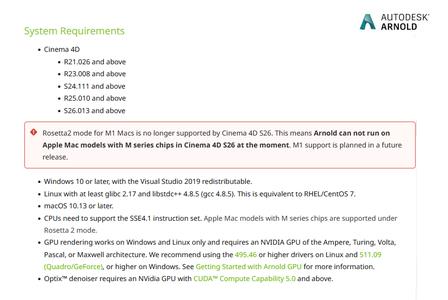
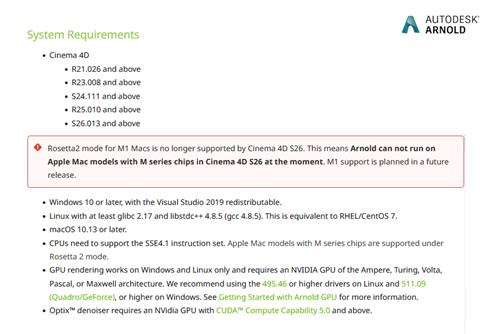
https://www.uploadcloud.pro/0mftrxh6qdi9/wnjbs.Linux.rar.html
https://www.uploadcloud.pro/xpzzugzojdx7/wnjbs.Mac.rar.html
https://www.uploadcloud.pro/hczf3oybvgl3/wnjbs.Win.rar.html

https://uploadgig.com/file/download/48993dE2c4174fde/wnjbs.Linux.rar
https://uploadgig.com/file/download/fDfFc4Ed877B234b/wnjbs.Mac.rar
https://uploadgig.com/file/download/fAdfB701c2515706/wnjbs.Win.rar

http://peeplink.in/d1ba0060e157

https://freshwap.cc/view/FE3F955136C42F1/wnjbs.Linux.rar[/url]
https://freshwap.cc/view/B4203716453C66A/wnjbs.Mac.rar[/url]
https://freshwap.cc/view/5690129CC657DD9/wnjbs.Win.rar[/url]
 Views: 18
Views: 18  Comments (0)
Comments (0)
free Solid Angle Cinema 4D to Arnold 4.3.0 (Windows / macOS / Linux ), Downloads Solid Angle Cinema 4D to Arnold 4.3.0 (Windows / macOS / Linux ), RapidShare Solid Angle Cinema 4D to Arnold 4.3.0 (Windows / macOS / Linux ), Megaupload Solid Angle Cinema 4D to Arnold 4.3.0 (Windows / macOS / Linux ), Mediafire Solid Angle Cinema 4D to Arnold 4.3.0 (Windows / macOS / Linux ), DepositFiles Solid Angle Cinema 4D to Arnold 4.3.0 (Windows / macOS / Linux ), HotFile Solid Angle Cinema 4D to Arnold 4.3.0 (Windows / macOS / Linux ), Uploading Solid Angle Cinema 4D to Arnold 4.3.0 (Windows / macOS / Linux ), Easy-Share Solid Angle Cinema 4D to Arnold 4.3.0 (Windows / macOS / Linux ), FileFactory Solid Angle Cinema 4D to Arnold 4.3.0 (Windows / macOS / Linux ), Vip-File Solid Angle Cinema 4D to Arnold 4.3.0 (Windows / macOS / Linux ), Shared Solid Angle Cinema 4D to Arnold 4.3.0 (Windows / macOS / Linux ), Please feel free to post your Solid Angle Cinema 4D to Arnold 4.3.0 (Windows / macOS / Linux ) Download, Movie, Game, Software, Mp3, video, subtitle, sample, torrent, NFO, Crack, uploaded, putlocker, Rapidgator, mediafire, Netload, Zippyshare, Extabit, 4shared, Serial, keygen, Watch online, requirements or whatever-related comments here.
Related Downloads :
{related-news}


